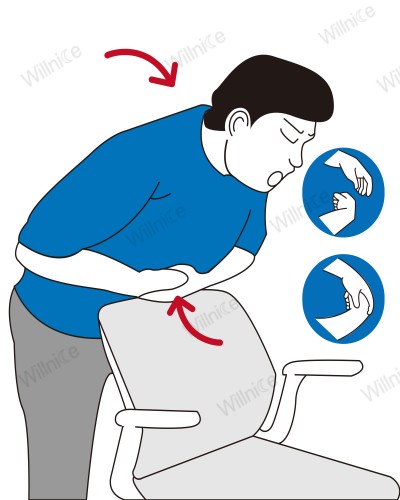
Choking is a serious and life-threatening emergency that can strike at any time. Therefore, it is very important for everyone, not only common people but also professionals, to have appropriate knowledge and skills to deal with such emergencies. This blog offers a coherent framework that deals with vital primary measures that should be undertaken in the event of an incident of choking. It presents various physiological mechanisms involved in choking, provides a description of the physiological parameters that serve to detect the presence of an obstruction, and offers stepwise descriptions of techniques that can be used to rescue a person. Understanding these basic first-aid tips can help the readers respond quickly to any emergencies while using the correct approach to ensure the best possible outcome.
 It is essential to understand the signs and symptoms of choking to be ready for management action. While a person is choking, typical manifestations are hands clutching the throat, coughing and gags, and breath sounds (or wheezing) with respiratory distress. The skin, such as the lips, may develop bluish discoloration (cyanosis) due to lack of oxygen. There may also be a marked decrease in the ability to speak, issue commands, or make any sounds. In extreme situations, the person even loses consciousness. Rapid recognition of these features is important to determine the presence of a complete airway block, which requires more aggressive maneuvers than the tough and potentially hazardous technique of expectoration.
It is essential to understand the signs and symptoms of choking to be ready for management action. While a person is choking, typical manifestations are hands clutching the throat, coughing and gags, and breath sounds (or wheezing) with respiratory distress. The skin, such as the lips, may develop bluish discoloration (cyanosis) due to lack of oxygen. There may also be a marked decrease in the ability to speak, issue commands, or make any sounds. In extreme situations, the person even loses consciousness. Rapid recognition of these features is important to determine the presence of a complete airway block, which requires more aggressive maneuvers than the tough and potentially hazardous technique of expectoration.
 Having performed and researched the Heimlich Maneuver – or abdominal thrusts as it is also known – on adults, there are broad stages that have to be followed, starting with the placement of the arms around the waist of the person who is choking. No doubt that the first step is to placate the person who is choking and inform them that they are safe since we all know that when someone panics, it only makes the situation worse. Stand behind the affected person and place your arms around their waist. While slightly separating it from the rib cage, just above the navel, a fist of one hand is placed. One hand grasps the other in order to firmly hold the fist. A number of quick upward thrusts are executed, forcing sufficient upward pressure beneath the diaphragm to exert enough force to dislodge the item without overexerting pressure to cause an injury. These abdominal thrusts should continue until the choking object is removed or the patient loses consciousness. It is not advisable to stop due to the risk of further complications. In the event the patient indeed loses consciousness, then lower the patient carefully onto the floor and prepare to commence CPR when required. As noted above, calmness and knowledge of the abovementioned steps, in combination, would significantly increase the chances of successfully helping the choking adult.
Having performed and researched the Heimlich Maneuver – or abdominal thrusts as it is also known – on adults, there are broad stages that have to be followed, starting with the placement of the arms around the waist of the person who is choking. No doubt that the first step is to placate the person who is choking and inform them that they are safe since we all know that when someone panics, it only makes the situation worse. Stand behind the affected person and place your arms around their waist. While slightly separating it from the rib cage, just above the navel, a fist of one hand is placed. One hand grasps the other in order to firmly hold the fist. A number of quick upward thrusts are executed, forcing sufficient upward pressure beneath the diaphragm to exert enough force to dislodge the item without overexerting pressure to cause an injury. These abdominal thrusts should continue until the choking object is removed or the patient loses consciousness. It is not advisable to stop due to the risk of further complications. In the event the patient indeed loses consciousness, then lower the patient carefully onto the floor and prepare to commence CPR when required. As noted above, calmness and knowledge of the abovementioned steps, in combination, would significantly increase the chances of successfully helping the choking adult.
 It’s widely and rightly understood that rescue choking techniques for babies are off-limits for readers who are challenged with executing them or who do not possess the specified skills or expertise. It’s important to point out that before the procedure commences, a clear decision needs to be made in regards to whether the child actually appears to be choking and their coughing is profound, or a wheezing sound is heard. In such a case, when there is an obstruction of the airway...The back blows work when the child has some foodstuff in their throat and even when it is choking, but the point which is additional is that it has to be recognized that these instances have to be performed when the child's head is lower than the chest. The head and neck cannot be massaged and grasped with the palm of the hand, but five sharp back blows need to be given between the left and the right blade of the shoulder. Five forceful blows follow this, and they are directed towards the abdomen. When these blows do not seem to work then the child can be turned over and pointed in the left direction. For instance, when these back blows and chest thrusts are alternating, it has to be made until the object inserted in the child's choking is free or until some medical expert arrives. After all the efforts, instead of panicking, the most critical aspect is to remember that with respect to an infant, there are several pointers to consider and points to be mastered, which are core essential for the infant to develop in the long run.
It’s widely and rightly understood that rescue choking techniques for babies are off-limits for readers who are challenged with executing them or who do not possess the specified skills or expertise. It’s important to point out that before the procedure commences, a clear decision needs to be made in regards to whether the child actually appears to be choking and their coughing is profound, or a wheezing sound is heard. In such a case, when there is an obstruction of the airway...The back blows work when the child has some foodstuff in their throat and even when it is choking, but the point which is additional is that it has to be recognized that these instances have to be performed when the child's head is lower than the chest. The head and neck cannot be massaged and grasped with the palm of the hand, but five sharp back blows need to be given between the left and the right blade of the shoulder. Five forceful blows follow this, and they are directed towards the abdomen. When these blows do not seem to work then the child can be turned over and pointed in the left direction. For instance, when these back blows and chest thrusts are alternating, it has to be made until the object inserted in the child's choking is free or until some medical expert arrives. After all the efforts, instead of panicking, the most critical aspect is to remember that with respect to an infant, there are several pointers to consider and points to be mastered, which are core essential for the infant to develop in the long run.
 Pregnant women or obese people who are suffering from Choking require deviation from normal procedures owing to anatomical issues. Start with ascertaining that the person is choking and is not making any sound or breathing adequately. In the case of pregnancy, chest thrusts are preferred, as abdominal thrusts are to be avoided. This reduces the chances of injury to the fetus and is in accordance with the distorted body shape. Also, for the obese, the conventional Heimlich maneuver techniques are likely to be ineffective, thereby necessitating chest thrusts to focus on the great abdominal diameter. Stand behind this person, encircle his or her chest with both hands and thrust your arms in and up. Throughout the process, keep track of the patient’s reaction and be prepared to contact emergency services, if necessary, at a moment’s notice. Such changes are intended to resolve the airway obstruction at lung and throat levels without causing harm as well deal with the other physical parameters.
Pregnant women or obese people who are suffering from Choking require deviation from normal procedures owing to anatomical issues. Start with ascertaining that the person is choking and is not making any sound or breathing adequately. In the case of pregnancy, chest thrusts are preferred, as abdominal thrusts are to be avoided. This reduces the chances of injury to the fetus and is in accordance with the distorted body shape. Also, for the obese, the conventional Heimlich maneuver techniques are likely to be ineffective, thereby necessitating chest thrusts to focus on the great abdominal diameter. Stand behind this person, encircle his or her chest with both hands and thrust your arms in and up. Throughout the process, keep track of the patient’s reaction and be prepared to contact emergency services, if necessary, at a moment’s notice. Such changes are intended to resolve the airway obstruction at lung and throat levels without causing harm as well deal with the other physical parameters.
 A strategic threefold approach of awareness, environment, and education is a solution to choking emergencies as per industry standards. First of all, ensure a silent atmosphere during meals to help the pace of eating. Inform people, specifically those who are more likely to be at risk – young children and the old – of the need to fully chew food before taking another bite and to be patient while eating. Altering the size of the food’s texture may also help; for example, one can cut food into manageable-sized segments and refrain from using dangerous foodstuffs such as hard candies and peanuts. Furthermore, understanding fundamental first aid measures and knowing how to respond to the risk of choking by caregivers or people around can greatly lessen the severity of such incidents if they occur. With all of these preventive strategies in place, the chances of choking emergencies are significantly less.
A strategic threefold approach of awareness, environment, and education is a solution to choking emergencies as per industry standards. First of all, ensure a silent atmosphere during meals to help the pace of eating. Inform people, specifically those who are more likely to be at risk – young children and the old – of the need to fully chew food before taking another bite and to be patient while eating. Altering the size of the food’s texture may also help; for example, one can cut food into manageable-sized segments and refrain from using dangerous foodstuffs such as hard candies and peanuts. Furthermore, understanding fundamental first aid measures and knowing how to respond to the risk of choking by caregivers or people around can greatly lessen the severity of such incidents if they occur. With all of these preventive strategies in place, the chances of choking emergencies are significantly less.
What Are the Signs and Symptoms of Choking?
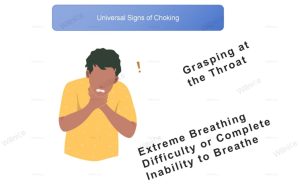 It is essential to understand the signs and symptoms of choking to be ready for management action. While a person is choking, typical manifestations are hands clutching the throat, coughing and gags, and breath sounds (or wheezing) with respiratory distress. The skin, such as the lips, may develop bluish discoloration (cyanosis) due to lack of oxygen. There may also be a marked decrease in the ability to speak, issue commands, or make any sounds. In extreme situations, the person even loses consciousness. Rapid recognition of these features is important to determine the presence of a complete airway block, which requires more aggressive maneuvers than the tough and potentially hazardous technique of expectoration.
It is essential to understand the signs and symptoms of choking to be ready for management action. While a person is choking, typical manifestations are hands clutching the throat, coughing and gags, and breath sounds (or wheezing) with respiratory distress. The skin, such as the lips, may develop bluish discoloration (cyanosis) due to lack of oxygen. There may also be a marked decrease in the ability to speak, issue commands, or make any sounds. In extreme situations, the person even loses consciousness. Rapid recognition of these features is important to determine the presence of a complete airway block, which requires more aggressive maneuvers than the tough and potentially hazardous technique of expectoration.
How to Recognize Symptoms of Choking
For instance, in the context of choking, I can draw attention to the most common signs that one is indeed in trouble. Coughing is typically the first response but in the case where the airway is obstructed further, coughing is followed by a silent wheeze. Looking for discoloration of the skin, particularly cyanotic regions, i.e., the lips or face areas, is crucial since their appearance reveals that a person is suffering from a deficiency of oxygen. In the same vein, if such a person who has just witnessed a sudden tongue cramp and has panic is able to hear the voice of the person panicking but dosing off, completely linear in coordination, then help is direly needed. These signs are essential, and understanding is vital for any person so that they know what to check first, especially in the case of airway blockages. In case it is a partial blockage, there is no need to panic, but if a complete blockage is proven, then I know exactly what first aid measures to take in a timely and effective manner.Understanding the Risk of Choking
It is important to assess the risk factors for choking to prevent such occurrences in sensitive populations such as the young and elderly. The first aspect to consider is age. Choking risk is high in children, as children under the age of three tend to mouth all small objects or put in small foods that can block their airways. Second, food intake is another prominent risk factor. Eating too fast or not chewing the food enough before swallowing puts people in even greater danger. Thirdly, some medical and health conditions significantly increase the choking risk, for instance, swallowing disorders or neurological diseases. What is more, poor dental fit or denture can affect the chewing processes and create susceptibility. Finally, the consumption of alcohol or taking sedatives can also be a contributing factor as it inhibits the nervous system, causing disruption in awareness and muscular coordination, which renders swallowing unsafe. Therefore, in order to limit the occurrence of choking incidents by understanding these parameters, we can minimize the chances of these, such as children being supervised while consuming food, children being taught to eat at a commendable pace, and children practicing adequate oral hygiene.Identifying a Choking Person
Recognizing someone who is choking is essential when carrying out timely interventions. These are the essential aids to consider while identifying the case:- Visible Distress: Alert for the common sign of distress, where the person places one or both hands at the neck region and cries for help, a popular sign of choking.
- Difficulty Breathing: Pay attention to the case where a person is gasping with abnormal sound or out of breath. This means that the person’s airway has been partially or completely secured.
- Inability to Speak or Cough: The situation when a person is not able to speak, shout or even carryout a force full cough is indicative of the serious blockage which needs to be addressed without delay.
- Skin Discoloration: It is essential to check if their skin especially the lips is becoming bluish or darkish as a result of lack of Oxygen which is scientifically referred to as cyanosis.
- Loss of Consciousness: Stay cautious in case the patient faints or doesn’t respond, as this is a critical indication that airway management is completely obstructed.
How to Perform the Heimlich Maneuver on Adults
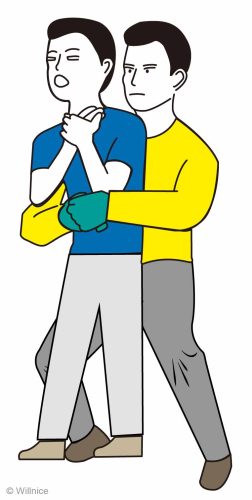 Having performed and researched the Heimlich Maneuver – or abdominal thrusts as it is also known – on adults, there are broad stages that have to be followed, starting with the placement of the arms around the waist of the person who is choking. No doubt that the first step is to placate the person who is choking and inform them that they are safe since we all know that when someone panics, it only makes the situation worse. Stand behind the affected person and place your arms around their waist. While slightly separating it from the rib cage, just above the navel, a fist of one hand is placed. One hand grasps the other in order to firmly hold the fist. A number of quick upward thrusts are executed, forcing sufficient upward pressure beneath the diaphragm to exert enough force to dislodge the item without overexerting pressure to cause an injury. These abdominal thrusts should continue until the choking object is removed or the patient loses consciousness. It is not advisable to stop due to the risk of further complications. In the event the patient indeed loses consciousness, then lower the patient carefully onto the floor and prepare to commence CPR when required. As noted above, calmness and knowledge of the abovementioned steps, in combination, would significantly increase the chances of successfully helping the choking adult.
Having performed and researched the Heimlich Maneuver – or abdominal thrusts as it is also known – on adults, there are broad stages that have to be followed, starting with the placement of the arms around the waist of the person who is choking. No doubt that the first step is to placate the person who is choking and inform them that they are safe since we all know that when someone panics, it only makes the situation worse. Stand behind the affected person and place your arms around their waist. While slightly separating it from the rib cage, just above the navel, a fist of one hand is placed. One hand grasps the other in order to firmly hold the fist. A number of quick upward thrusts are executed, forcing sufficient upward pressure beneath the diaphragm to exert enough force to dislodge the item without overexerting pressure to cause an injury. These abdominal thrusts should continue until the choking object is removed or the patient loses consciousness. It is not advisable to stop due to the risk of further complications. In the event the patient indeed loses consciousness, then lower the patient carefully onto the floor and prepare to commence CPR when required. As noted above, calmness and knowledge of the abovementioned steps, in combination, would significantly increase the chances of successfully helping the choking adult.
- Stay Calm: It is wise indeed to say that keeping the individual calm is the priority, for it would help in giving an assurance that help is on the way and would probably reduce any chances of a panic attack, which may end up worsening the situation in itself.
- Positioning: The individual should be standing behind the individual. In this position, you are able to assist the individual as well as perform the maneuver without problems. Then placing both arms around their waist for a supportive grip.
- Fist Placement: One of the palms should be made into a fist and positioned right above the individual’s navel. This placement is critical because it is very much the spot where the decent amount of force could be used without inhibiting other organs.
- Grasp and Support: The other hand should be cupped around the fist. This additional grip gives more force on to the thrusts and at the same time enables the thrusts to be focused and again under control.
- Perform Upward Thrusts: With your fist, thrust forcefully in an upward direction. The aim is to produce enough pressure that will free the airway passage. It is important to apply sufficient force to dislodge the object yet low enough to avoid causing injury to the individual.
- Repeat if Necessary: Continue to apply the thrusts until the object comes out, or until that person seems better. In rare cases a person may lose consciousness, if that happens it would be gentler to put them on the bed and probably start the CPR.
Using Abdominal Thrusts Effectively
Specific rules have to be adhered to while relieving choking by the application of abdominal thrusts, which enhance the safety and effectiveness of the maneuver. In this case, we delineate such rules in detail:- Correct Hand Placement: The clenched fist should be placed precisely above the navel and below the rib cage. This positioning is crucial as it targets the diaphragm, so increasing the chances of removing the obstruction without any harm to internal organs.
- Firm Grip: Grasp your fist with the other hand so as to provide force and controlled thrust. Moreover strengthening the grip improves effective force delivery with little or no chances of slipping or causing more trouble to the person choking.
- Force and Depth of Thrusts: Execute this thrust by using a balance of force that is vigorous enough to dislodge the foreign object but not too vigorous to damage certain groups of people, especially the elderly and sick ones. Use controlled and short thrusting motion done upwards to achieve this aim.
- Observation of Response: Always look at the person’s response to each thrust and absorb whatever change occurs. If there is no improvement then consistent readjustment of the thrust position and force must be done. Visual signs such as coughing or regaining voice are signs that indicate success of the aim.
- Continued Assessment: If the obstruction continues for more than a minute, then be prepared to switch to CPR if the person becomes unconscious. There is a dire need to first call for an ambulance while revolving the person to the ground and starting the resuscitation process.
When to Call 9-1-1 During a Choking Emergency
There are a number of signs that indicate a person has reached a state of no return or there’s no hope for recovery, and therefore, emergency services should be contacted. In the case of choking, these indicators arise in the following scenarios:- Obstruction Not Clearable: When an individual has not been able to cough out the obstruction after a set of several abdominal thrusts, it is advisable to seek help as the situation seems to have forged itself.
- Loss of Consciousness: If the choking individual does not move or open their mouth despite trying to get them to do so, there is a dire need for help from trained medical personnel.
- Severe Respiratory Distress: Identify the noticeable problems that someone suffering might have difficulties in breathing, some of the more apparent signs include wheezing, gasping and poor respiratory effort. In this case, please do not hesitate to call 9-1-1.
- Cyanosis Development: Darkening of skin surrounding the lips and fingertips due to low levels of oxygen in the body is referred to as cyanosis , this is dangerous and therefore requires immediate medical attention.
- Pre-existing Conditions or Frailty: Be cautious in your approach and if the patient is elderly, weak or has a known disease, do not dawdle and contact emergency services in advance.
What is the First Aid for Choking Infants?
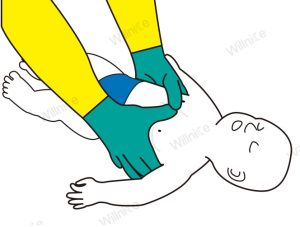 It’s widely and rightly understood that rescue choking techniques for babies are off-limits for readers who are challenged with executing them or who do not possess the specified skills or expertise. It’s important to point out that before the procedure commences, a clear decision needs to be made in regards to whether the child actually appears to be choking and their coughing is profound, or a wheezing sound is heard. In such a case, when there is an obstruction of the airway...The back blows work when the child has some foodstuff in their throat and even when it is choking, but the point which is additional is that it has to be recognized that these instances have to be performed when the child's head is lower than the chest. The head and neck cannot be massaged and grasped with the palm of the hand, but five sharp back blows need to be given between the left and the right blade of the shoulder. Five forceful blows follow this, and they are directed towards the abdomen. When these blows do not seem to work then the child can be turned over and pointed in the left direction. For instance, when these back blows and chest thrusts are alternating, it has to be made until the object inserted in the child's choking is free or until some medical expert arrives. After all the efforts, instead of panicking, the most critical aspect is to remember that with respect to an infant, there are several pointers to consider and points to be mastered, which are core essential for the infant to develop in the long run.
It’s widely and rightly understood that rescue choking techniques for babies are off-limits for readers who are challenged with executing them or who do not possess the specified skills or expertise. It’s important to point out that before the procedure commences, a clear decision needs to be made in regards to whether the child actually appears to be choking and their coughing is profound, or a wheezing sound is heard. In such a case, when there is an obstruction of the airway...The back blows work when the child has some foodstuff in their throat and even when it is choking, but the point which is additional is that it has to be recognized that these instances have to be performed when the child's head is lower than the chest. The head and neck cannot be massaged and grasped with the palm of the hand, but five sharp back blows need to be given between the left and the right blade of the shoulder. Five forceful blows follow this, and they are directed towards the abdomen. When these blows do not seem to work then the child can be turned over and pointed in the left direction. For instance, when these back blows and chest thrusts are alternating, it has to be made until the object inserted in the child's choking is free or until some medical expert arrives. After all the efforts, instead of panicking, the most critical aspect is to remember that with respect to an infant, there are several pointers to consider and points to be mastered, which are core essential for the infant to develop in the long run.
How to Handle a Choking Baby
A choking baby is one of those dire scenarios that one ought to be prepared for, and in the best manner possible, too. Allow me to explain what you need to follow step-by-step, with adequate emphasis on keeping it simple. First, you will confirm that the baby is choking. You will notice that if the baby is making an effort to cry, cough, or breathe properly, then it indicates choking.- Positioning the Baby: Starting whichever baby face down on your forearm which helps keep their head lower than their chest , alongside supporting both their head and neck. Which helps and expands both airways and the help of gravity towards getting rid of the obstruction.
- Back Blows: Utilizing the palm heel, direct that palm to give five thumping strikes at the mid-region of both shoulder blades on the baby’s back. These firmer slaps must not be rough, as they need enough force to be able to get the blockage free while avoiding any form of violence to the baby.
- Chest Thrusts: In an event that the obstruction does not go away, Turn the baby on their back once more while ensuring their head is lower than the chest and then apply 5 gentle but firm chest thrusts, using two fingers, around the baby’s breast area. Performing these thrusts however would be quite similar to CPR, as its purpose is to remove the object from the baby’s throat.
- Alternating Actions: Switch the back slaps and the chest thrusts until the baby either swallows the object orthe aid arrives. Switching between either one of those is strongly advised as it strikes different points of the throat and creates new chances of miniature blockades.
Understanding Back Blows and Chest Thrusts
I will elaborate on the significance and implementation of back blows and chest thrusts in a more understandable way. These maneuvers are very important when performing in the case of an infant who is choking, where the objective is to dislodge the foreign object entirely and with the utmost speed.Back Blows involve a few key steps:
- Positioning: With the child's face looking down and their head nestled between the upper part of the chest and forearm, the burr obstructing airflow is more likely to be dislodged thanks to gravitational force,which comes into effect through this position.
- Support: The support should be strong enough to guarantee the neck and head of the infant are stable enough to allow the infant's airway to remain unblocked.
- Blows: To do this, five sharp back blows between the shoulder blades utilizing the palm should be enough. Do not apply too much force, as this could cause harm, but do push hard enough to remove the obstruction.
Chest Thrusts can be understood as follows:
- Face-up Position: If the back blows do not work, turn the infant to a face-up position on the other forearm. Always the head lower than the chest.
- Thrust Application: Use two fingers just below the nipple line and perform five chest thrusts which are gentle. Each should be firm but controlled, very much like chest compression as done in CPR, on a small scale.
- Alternating: If the object still does not come out, continue alternating back blows with chest thrusts. The important thing is to be calm and note any signs or symptoms in the infant.
How to Help Someone Who is Pregnant or Obese and Choking?
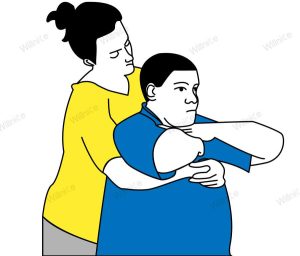 Pregnant women or obese people who are suffering from Choking require deviation from normal procedures owing to anatomical issues. Start with ascertaining that the person is choking and is not making any sound or breathing adequately. In the case of pregnancy, chest thrusts are preferred, as abdominal thrusts are to be avoided. This reduces the chances of injury to the fetus and is in accordance with the distorted body shape. Also, for the obese, the conventional Heimlich maneuver techniques are likely to be ineffective, thereby necessitating chest thrusts to focus on the great abdominal diameter. Stand behind this person, encircle his or her chest with both hands and thrust your arms in and up. Throughout the process, keep track of the patient’s reaction and be prepared to contact emergency services, if necessary, at a moment’s notice. Such changes are intended to resolve the airway obstruction at lung and throat levels without causing harm as well deal with the other physical parameters.
Pregnant women or obese people who are suffering from Choking require deviation from normal procedures owing to anatomical issues. Start with ascertaining that the person is choking and is not making any sound or breathing adequately. In the case of pregnancy, chest thrusts are preferred, as abdominal thrusts are to be avoided. This reduces the chances of injury to the fetus and is in accordance with the distorted body shape. Also, for the obese, the conventional Heimlich maneuver techniques are likely to be ineffective, thereby necessitating chest thrusts to focus on the great abdominal diameter. Stand behind this person, encircle his or her chest with both hands and thrust your arms in and up. Throughout the process, keep track of the patient’s reaction and be prepared to contact emergency services, if necessary, at a moment’s notice. Such changes are intended to resolve the airway obstruction at lung and throat levels without causing harm as well deal with the other physical parameters.
Adapting Techniques for Pregnant or Obese People
To start with, I would like to clarify how assistance can be rendered to such a person who is either obese or pregnant and facing a choking situation. It should be noted that the first step in any choking emergency is to ascertain whether the individual is indeed choking by checking if they have any speaking or breathing capacity. In cases where there is a pregnant person, chest thrusts have to be used instead of abdominal thrusts, and for obvious reasons:- Anatomical Considerations: The expanding size of the fetus modifies the layout of the abdomen, and inappropriately exerting pressure may, most probably, instigate injury to the fetus. Chest thrusts are used to direct the force more safely away from the abdomen.
- Positioning: F or pregnant patients, the correct method for performing the thrusts requires placing the hands at the center of the patient’s chest. This safeguarding measure aims at avoiding injury to any fetus in case the obstruction is aimed at being expelled.
- Physical Adaptation: There is a likelihood that the chest thrusts, like those of pregnant people are modified in such a way as to enable the movement of the hands over the abdominal area, in this case the diaphragm region more effectively without the hand sliding.
- Execution of Chest Thrusts: Move to the back of the patient, clasp their hands at the level of the patients’ chest and push the hands in and upwards in a thrusting motion. Ensure a good footing so that effective force can be used.
Using Chest Thrusts Instead of Abdominal
let me make it clear why using the chest thrust technique on specific patients is safer and more effective than the abdominal thrusts. This technique comes in handy when one has to deal with cases such as pregnant or obese people who are choking. The reasons are brought forth clearly. They are as follows:- Safety for Pregnant Women: The chest thrust technique does not exert pressure on the abdomen, and hence, together with the fetus, the mother is safe. Adding a direct force during pregnancy can be harmful because the abdominal region is more delicate and intricate than other body regions.
- Body Adaptation for Obese Individuals: Having a wider abdominal distance makes chest thrusts tactically more reasonable and effective. The maneuver should never be accompanied by hand slippage, meaning the applied force should only be directed toward the diaphragm.
- Correct Hand Placement: For the pregnant as well as the obese ones, it is always advisable to place the hands at the center of the chest since it is critical to generate adequate force without causing damage to the person who is choking.
- Ease of Execution: Once the arms encircle the upper chest of the choking person, you can push up and in with the lower arms, both of which are more straightforward to do and give better outcomes.
- Emergency Response: It is important to observe the situation of the affected person at every point. In case of no progress in removing the blockage in a short time, an emergency medical service should be requested and the maneuvers should still be performed.
How Can You Prevent Choking Emergencies?
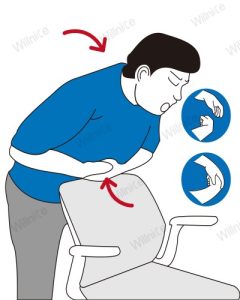 A strategic threefold approach of awareness, environment, and education is a solution to choking emergencies as per industry standards. First of all, ensure a silent atmosphere during meals to help the pace of eating. Inform people, specifically those who are more likely to be at risk – young children and the old – of the need to fully chew food before taking another bite and to be patient while eating. Altering the size of the food’s texture may also help; for example, one can cut food into manageable-sized segments and refrain from using dangerous foodstuffs such as hard candies and peanuts. Furthermore, understanding fundamental first aid measures and knowing how to respond to the risk of choking by caregivers or people around can greatly lessen the severity of such incidents if they occur. With all of these preventive strategies in place, the chances of choking emergencies are significantly less.
A strategic threefold approach of awareness, environment, and education is a solution to choking emergencies as per industry standards. First of all, ensure a silent atmosphere during meals to help the pace of eating. Inform people, specifically those who are more likely to be at risk – young children and the old – of the need to fully chew food before taking another bite and to be patient while eating. Altering the size of the food’s texture may also help; for example, one can cut food into manageable-sized segments and refrain from using dangerous foodstuffs such as hard candies and peanuts. Furthermore, understanding fundamental first aid measures and knowing how to respond to the risk of choking by caregivers or people around can greatly lessen the severity of such incidents if they occur. With all of these preventive strategies in place, the chances of choking emergencies are significantly less.
Understanding Choking Hazards in Daily Life
Identifying potential choking risks in everyday life is not an easy task, even for an industry expert such as myself. One has to keep in mind the activities as well as the surroundings within which the risks may come up. To illustrate, children, the elderly, and people with certain querulous medical conditions appear to be the worst affected. Through one’s lived experience, small toys, coins, and some foods considered obstructive, such as grapes, nuts, and popcorn, can be regarded as everyday choking threats. Policies Naumann Wahner once suggested every caretaker of a vulnerable individual should follow are: out of reach of toddlers we place smaller objects, safely restricting inappropriate toys, and slowly blending the food for weaker segments of her population. In this regard, being one of the more overzealous risk avoiders is just as constructive if not enabling - in being able to raise awareness while protecting those who need looking after, which in turn diminishes the chances of people choking there during those particular instances.Why is First Aid Training Important for Choking Emergencies?
First aid training for chokers is important because it helps people to act quickly and properly. This training makes it possible for people who have witnessed choking to identify the symptoms and use emergency intervention measures, including the Heimlich maneuver or chest thrusts, which could save lives. Choking is an incipient life-threatening condition, and having operational skilled personnel present improves the chances of a favorable outcome through rapid removal of the obstruction while preventing hypoxia. First aid training further improves the confidence and preparedness of individuals, which lowers anxiety and guarantees effective decisiveness and action. Hence, it has a very important function of promoting public health and preparedness on how to address a choking emergency in the most effective manner.Learning First Aid Skills and Techniques
which is backed with years of experience; acquiring first aid skills and techniques is crucial not only for the individual in question but also for the whole society. These abilities instill confidence in the population in times of crisis, for example, when there is a case of choking. First Aid courses involve a variety of practical actions, from performing abdominal and chest thrusts to performing mouth-to-mouth resuscitation and dressing a wound. When I demonstrate these techniques, I also explain when and why they are useful so that participants acquire not only the know-how but the know-how integrated with the presence of mind under pressure. Since these skills spring from practice, refreshers and demonstrations are vital to keeping the skills available and ready for action. As a result, all time spent in first aid training is time well spent in making the environment safer, and more alert.Benefits of Taking a First Aid Course
In my opinion, taking a first aid course is of tremendous importance as it will allow me to do much more than just acquire the relevant techniques. This is why this obligatory training makes sense – here are some salient points:- Life-Saving Skills: Most importantly, a first aid course is aimed at equipping people with the knowledge and skills needed to take action in critical situations such as choking, heart attacks and other life threatening events. This could be the deciding factor of one’s life or death.
- Increased Confidence: When you have the know how to respond or act during a critical moment, your confidence level increases. You are not going to be hopeless in the case of a crisis and that in itself can help you to secure the necessary strength to perform the required actions to help.
- Preparedness for Emergencies: The course develops and prepares you for different situations through skills such as CPR, AED and wound care. Preparation enhances the ability to respond to an emergency within a short period, which heightens the possibility of a good outcome.
- Empowerment: Empowering the person can be illustrated through the knowledge of how to assist someone in a time when they are most vulnerable. It helps to have you assume control on occasions when a patient needs to be seen immediately.
- Enhanced Community Safety: On a wider scale, more individuals learning first aid increases community safety altogether. It develops a map of people who constantly assist one another, particularly in crowded areas and during community activities.
- Workplace Safety Compliance: It is apparent that first aid training is a vital business asset since many organizations incorporate it as part of their safety policies which essentially improves your chances of getting an employment in the organization.
- Knowledge Enhancement: Its worthy to go through a first aid course not just for practical skills but as well to improve your knowledge of how humans function and how they react after sustaining injuries, which is quite interesting and insightful.
Reference
- Mayo Clinic: Choking First Aid
- Johns Hopkins Medicine: Choking First Aid and Prevention
- American Red Cross: Adult & Child Choking First Aid
- St John Ambulance: Adult Choking First Aid Advice
Frequently Asked Questions (FAQs)
Q: What should I do first if someone is choking?
A: If someone is choking, the first step is to assess the situation to determine if they can cough or speak. If they cannot, you should begin giving sharp blows to the back to try to dislodge the blockage.Q: How do I perform back blows on someone who is choking?
A: To perform back blows on someone who is choking, stand behind the person and give five sharp blows between the shoulder blades with the heel of your hand. This can help to potentially save a life by clearing the airway.Q: What are abdominal thrusts, and how are they performed?
A: Abdominal thrusts, also known as the Heimlich maneuver, involve standing behind the person, placing a fist above their navel, and giving 5 quick, upward thrusts. This is done after back blows to help clear the obstruction.Q: When should I use chest thrusts instead of abdominal thrusts?
A: Chest thrusts should be used if the person is too large to wrap your arms around or if the person is pregnant. Place your hands in the center of the person's chest and give 5 chest thrusts.Q: What can I do if the person becomes unconscious?
A: If the person becomes unconscious, you should call for emergency help and begin CPR immediately. Tilt the person's head back slightly to open the airway and commence chest compressions.Q: How can I prevent someone from choking?
A: Choking prevention includes cutting food into small pieces, encouraging thorough chewing, and avoiding talking or laughing while eating. Be mindful of high-risk foods and small objects that could cause choking.Q: Are there any mobile resources to assist with choking first aid?
A: The American Red Cross and other organizations offer first aid apps that provide guidance on how to handle choking and other emergencies effectively.Q: Can I cause injury while trying to help a choking person?
A: While there is a potential to cause injury with abdominal thrusts or chest thrusts, these actions are necessary to dislodge the blockage and can be life-saving. Proper technique helps minimize risks.Q: How often should I practice CPR and first aid techniques?
A: Regularly refreshing your knowledge and skills with certified courses from organizations like the American Red Cross ensures you are prepared to help effectively in emergencies.Q: What are some signs that someone is at high risk for choking?
A: Individuals at high risk for choking include young children, elderly adults, and people with certain medical conditions. Being aware of these risks can help in taking precautionary measures.1611


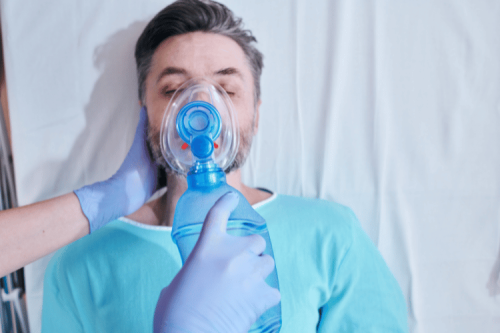
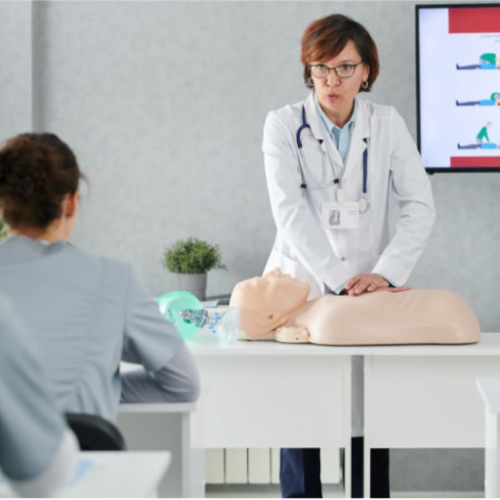
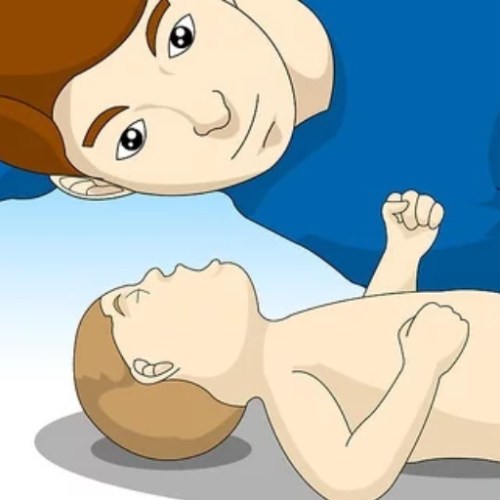


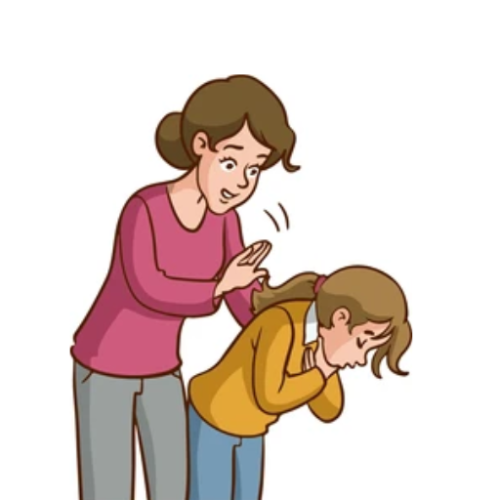
 Login with Google
Login with Google Login with Facebook
Login with Facebook